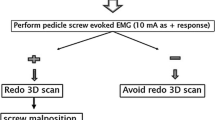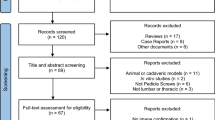Abstract
This study was aimed at evaluating the sensitivity and safety of a new technique to record triggered EMG thresholds from axillary chest wall electrodes when inserting pedicle screws in the upper thoracic spine (T2–T6). A total of 248 (36.6%) of a total of 677 thoracic screws were placed at the T2–T6 levels in 92 patients with adolescent idiopathic scoliosis. A single electrode placed at the axillary midline was able to record potentials during surgery from all T2–T6 myotomes at each side. Eleven screws were removed during surgery because of malposition according to intraoperative fluoroscopic views. Screw position was evaluated after surgery in the remaining 237 screws using a CT scan. Malposition was detected in 35 pedicle screws (14.7%). Pedicle medial cortex was breached in 24 (10.1%). Six screws (2.5%) were located inside the spinal canal. Mean EMG threshold was 24.44 ± 11.30 mA in well-positioned screws, 17.98 ± 8.24 mA (p < 0.01) in screws violating the pedicle medial cortex, and 10.38 ± 3.33 mA (p < 0.005) in screws located inside the spinal canal. Below a threshold of 12 mA, 33.4% of the screws (10/30) were malpositioned. Furthermore, 36% of the pedicle screws with t-EMG stimulation thresholds within the range 6–12 mA were malpositioned. In conclusion, assessment of upper thoracic pedicle screw placement by recording tEMG at a single axillary electrode was highly reliable. Thresholds below 12 mA should alert surgeons to suspect screw malposition. This technique simplifies tEMG potential recording to facilitate safe placement of pedicle screws at upper thoracic levels.





Similar content being viewed by others
References
Calanchie B, Lebwohl N, Madsen P, Klose KJ (1992) Intraoperative evoked EMG monitoring in an animal model. Spine 17:1229–1235
Lenke LG, Padberg AM, Russo MH, Bridwell Kh, Gelb DE (1995) Triggered electromyographic threshold for accuracy of pedicle screw placement. An animal model and clinical correlation. Spine 20:1585–1591
Danesh-Clough T, Taylor P, Hodgson B, Walton M (2001) The use of evoked EMG in detecting misplaced thoracolumbar pedicle screws. Spine 26:1313–1316
Raynor BL, Lenke LG, Kim Y, Hanson DS, Wilson-Holden TJ, Bridwell KH, Padberg AM (2002) Can triggered electromyography thresholds predict safe thoracic pedicle screw placement? Spine 27:2030–2035
De Blas G, Burgos J, Regidor I, Barrios C, Solá R, García-Urquiza S, Hevia E (2009) Recording diffusion responses from contralateral intercostal muscles after stimulus-triggered electromyography. Refining a tool for the assessment of thoracic pedicle screw placement in an experimental porcine model. Spine 34:391–396
Norton JA, Hedden DM (2009) Monitoring placement of high thoracic pedicle screws by triggered electromyography of the intercostal muscles. Can J Surg 52:E47–E48
Rodriguez-Olaverri JC, Zimick NC, Merola A, De Blas G, Burgos J, Piza-Vallespir G, Hevia E, Vicente J, Sanpera I, Domenech P, Regidor I (2008) Using triggered electromyographic threshold in the intercostal muscles to evaluate the accuracy of upper thoracic pedicle screw placement (T3–T6). Spine 33:194–197
Kim YJ, Lenke LG, Bridwell KH, Cho YS, Riew KD (2004) Free hand pedicle screw placement in the thoracic spine: is it safe? Spine 29:333–342
Suk S, Lee C, Kim W, Chung Y, Park Y (1995) Segmental pedicle screw fixation in the treatment of thoracic idiopathic scoliosis. Spine 20:1399–1405
Vaccaro AR, Rizzolo SJ, Allardyce TJ, Ramsey M, Salvo J, Balderston RA, Cotler JM (1995) Placement of pedicle screws in the thoracic spine: I. Morphographic analysis of the thoracic vertebrae. J Bone Joint Surg Am 77:1193–1199
Vaccaro AR, Rizzolo SJ, Balderston RA, Allardyce TJ, Garfin SR, Dolinkas C, An HS (1995) Placement of pedicle screws in the thoracic spine: II. An anatomical and radiographic assessment. J Bone Joint Surg Am 77:1200–1206
Xu R, Ebraheim N, Ou Y, Yeasting RA (1998) Anatomic considerations of pedicle screw placement in the thoracic spine. Spine 23:1065–1068
Weinstein J, Rydevik B, Rauschning W (1992) Anatomic and technical considerations of pedicle screw fixation. Clin Orthop 284:34–46
Panjabi MM, O’Holleran JD, Crisco JJ 3rd, Kothe R (1997) Complexity of the thoracic spine pedicle anatomy. Eur Spine J 6:19–24
Ugur HC, Attar A, Uz A, Tekdemir I, Egemen N, Genç Y (2001) Thoracic pedicle: surgical anatomic evaluation and relations. J Spinal Disord 14:39–45
Lewis SJ, Lenke LG, Raynor B, Long J, Bridwell KH, Padberg A (2001) Triggered electromyographic threshold for accuracy of thoracic pedicle screw placement in a porcine model. Spine 26:2485–2489
Shi Y-B, Binette M, Martin WH, Pearson JM, Hart RA (2003) Electrical stimulation for intraoperative evaluation of thoracic pedicle screw placement. Spine 28:595–601
Holland N (1998) Intraoperative electromyography during thoracolumbar spinal surgery. Spine 23:1915–1922
Reidy DP, Houlden D, Nolan PC, Kim M, Finkelstein JA (2001) Evaluation of electromyographic monitoring during insertion of thoracic pedicle screws. J Bone Joint Surg Br 83:1009–1014
Conflict of interest
No conflict of interest.
Author information
Authors and Affiliations
Corresponding author
Rights and permissions
About this article
Cite this article
Regidor, I., de Blas, G., Barrios, C. et al. Recording triggered EMG thresholds from axillary chest wall electrodes: a new refined technique for accurate upper thoracic (T2–T6) pedicle screw placement. Eur Spine J 20, 1620–1625 (2011). https://doi.org/10.1007/s00586-011-1800-z
Received:
Revised:
Accepted:
Published:
Issue Date:
DOI: https://doi.org/10.1007/s00586-011-1800-z




